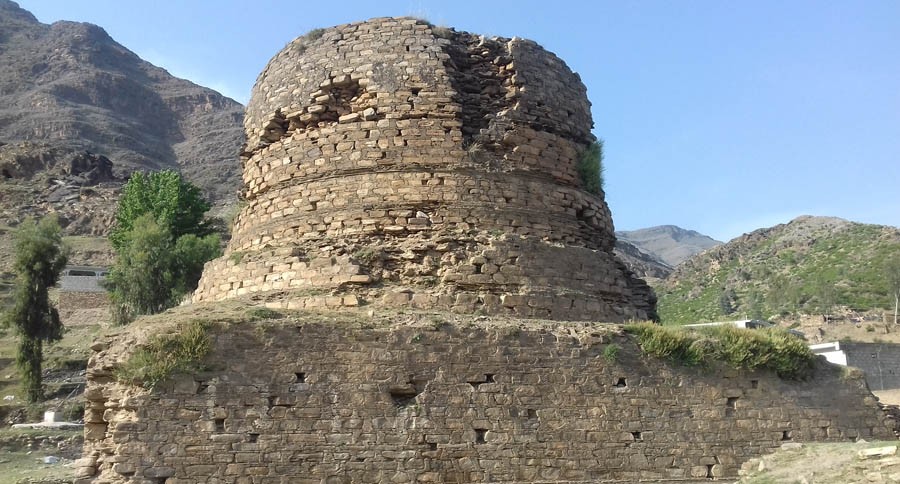
The monumental landscape of Gumbatuna in Swat valley requires our urgent attention

Swat is spotted by traces of grandeur that it enjoyed through the first millennium of the current era. The urban accomplishments are concentrated in areas like Barikot-Ghwandai and Udigram. Still, the predominant celestial considerations, in the form of Buddhist sacred complexes, can be found in scenic valleys such as Malam Jabba, Jambil, Saidu, Karakar, Amluk Dara, Tokar Dara and all along the banks of Swat river.
Upon entering Swat one is greeted by the imposing stupa on the left bank of the river, known as Shangardar stupa, near Ghaligai. This majestic heritage knows no bounds as one proceeds further into the valley. However, I would limit myself here to an important site called Gumbatuna which is facing eminent extinction.
Gumbatuna (the singular is gumbat) means domes or stupas. It is situated, almost opposite the Shangardar stupa, near Shamozai on the newly reconstructed highway, on the right bank of Swat River, from Chakdara through Kabal to Upper Swat. The site can be a potential rival to the well-known stupas and monasteries of Swat. It is rich insofar as architectural and artistic details, landscape context and cultural tourism are concerned. However, the site is prone to vandalism and weathering vagaries.
Gumbatuna is a protected site sprawled over a large area. Protected sites are those which after being gauged from historical, artistic and national/international viewpoints are formally in the light of archaeological laws, they are declared as state property. In Pakistan, a long list of such heritage places is available. It is ironic that some of these sites are non-existent now except on paper. Gumbatuna should not be driven to such a fate.
Gumbatuna was earlier visited and recorded by Aurel Stein, Burger & Right and G. Tucci and it saw ‘salvage excavation’ in 1992 under the leadership of experienced archaeologist Dr Ashraf Khan. He prioritised this work in view of the site’s "importance as a repository of cultural heritage and a potential place for the attraction of tourists". It may also be noted that the excavation was of limited scope.
The excavator exposed an imposing stupa surrounded by more than 20 small stupas. The masonry in which the monuments have been executed is known as diaper, a large hewn blocks of stone with the interstices between them filled artistically with small pieces of stone. The buildings were plastered with lime as is common to almost all such buildings in Khyber Pakhtunkhwa. The lifespan of Gumbatuna is suggested to be between the second to the seventh or eighth century. The heritage value represented by Gumbatuna is of considerable significance and needs serious attention.
It is interesting to recount Dr Ashraf’s words that Gumbatuna was excavated "in view of the increasing clandestine activities of the antiquity hunters". The remaining curios were no doubt rescued and moved to the Swat Museum. But it may also be recalled that archaeological heritage is not all about portable antiquities. The structural aspect of this scarce resource is similarly paramount. Its preservation needs a well thought-out scheme such as continuous restoration, appointment of attendants, vigilant presence against land grabbers and stone hunters, fencing and so on. Similarly, officials’ regular inspections are also highly required. The lack of professional vigour that Gumbatuna and all other historical monuments throughout Pakistan seem destined to disappear.
The monumental landscape of Gumbatuna should be given attention urgently. On the one hand the site is threatened by the rapidly expanding colony around it, and on the other hand the monuments are also subject to decay due to natural and biological factors. Gumbatuna has already experienced destruction both before and after the excavation. Most of the minor stupas have been replaced by a cricket ground and the central stupa seems to be heading for a same fate. Curative measures, therefore, are urgently needed lest the remaining heritage is lost forever.
Let’s speculate about the cultural vitality of Gumbatuna. In the first place, the site embodies great potential vis-à-vis tourism since it is so easily accessible. It is situated at the bottom of the Shamozai mountain range just above the bank of Swat River. All the monastic monuments are aesthetically embedded into the surrounding landscape. And it shows the pattern of careful selection by Buddhists for their places of worship. Scholars have recently started to focus on this feature of Gandharan archaeology, more specifically, Italian archaeologists have fared well in this respect in Swat.
Finally, Gumbatuna is the only site on the right bank of Swat River, except Nimogram which is out of easy access, that rivals internationally popular sites such as Barikot or Saidu, on the right bank of the river.